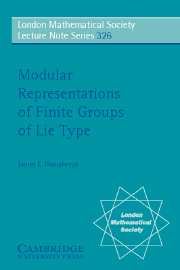Book contents
- Frontmatter
- Contents
- Preface
- 1 Finite Groups of Lie Type
- 2 Simple Modules
- 3 Weyl Modules and Lusztig's Conjecture
- 4 Computation of Weight Multiplicities
- 5 Other Aspects of Simple Modules
- 6 Tensor Products
- 7 BN-Pairs and Induced Modules
- 8 Blocks
- 9 Projective Modules
- 10 Comparison with Frobenius Kernels
- 11 Cartan Invariants
- 12 Extensions of Simple Modules
- 13 Loewy Series
- 14 Cohomology
- 15 Complexity and Support Varieties
- 16 Ordinary and Modular Representations
- 17 Deligne–Lusztig Characters
- 18 The Groups G2(q)
- 19 General and Special Linear Groups
- 20 Suzuki and Ree Groups
- Bibliography
- Frequently Used Symbols
- Index
16 - Ordinary and Modular Representations
Published online by Cambridge University Press: 23 November 2009
- Frontmatter
- Contents
- Preface
- 1 Finite Groups of Lie Type
- 2 Simple Modules
- 3 Weyl Modules and Lusztig's Conjecture
- 4 Computation of Weight Multiplicities
- 5 Other Aspects of Simple Modules
- 6 Tensor Products
- 7 BN-Pairs and Induced Modules
- 8 Blocks
- 9 Projective Modules
- 10 Comparison with Frobenius Kernels
- 11 Cartan Invariants
- 12 Extensions of Simple Modules
- 13 Loewy Series
- 14 Cohomology
- 15 Complexity and Support Varieties
- 16 Ordinary and Modular Representations
- 17 Deligne–Lusztig Characters
- 18 The Groups G2(q)
- 19 General and Special Linear Groups
- 20 Suzuki and Ree Groups
- Bibliography
- Frequently Used Symbols
- Index
Summary
Until now we have limited our discussion to representations in the defining characteristic p. But in this and the following chapter we look at connections with representations in characteristic 0. For convenience we use the term ordinary representation (or character) to mean a ℂG-module (or its character) and the term modular representation (or character) to mean a KG-module (or its Brauer character).
Brauer's study of modular representations was largely intended to provide new tools for the study of ordinary representations. There turn out to be intimate connections between the two theories, encapsulated in the decomposition matrix. We review the general theory briefly in 16.1–16.4 before turning to groups of Lie type. Blocks and their defect groups play an essential organizing role throughout. The decomposition behavior for blocks with a cyclic (possibly trivial) defect group is well understood for arbitrary finite groups, but has limited applicability to groups of Lie type (16.6–16.7).
To put the comparison of ordinary and modular characters in perspective, we take a detailed look at the family SL(2, q) in 16.8–16.10. This is a useful though oversimplified prototype for other groups of Lie type.
One obstacle to studying higher rank groups is the far greater complexity of their ordinary character theory. We recall in 16.11 some special cases in which characters have been worked out, mainly prior to the Deligne–Lusztig theory of the mid-1970s (to which the next chapter is devoted).
- Type
- Chapter
- Information
- Modular Representations of Finite Groups of Lie Type , pp. 159 - 170Publisher: Cambridge University PressPrint publication year: 2005



